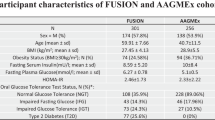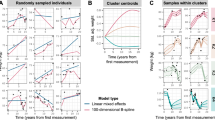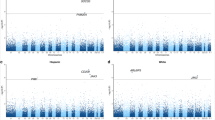Abstract
Obesity is a major public health concern in Mexico and worldwide. Although the estimated heritability is high, common variants identified by genome-wide association studies explain only a small proportion of this heritability. A combination of linkage and association strategies could be a more robust and powerful approach to identify other obesity-susceptibility variants. We thus sought to identify novel genetic variants associated with obesity-related traits in the Mexican population by combining these methods. We performed a genome-wide linkage scan for body mass index (BMI) and other obesity-related phenotypes in 16 Mexican families using the Sequential Oligogenic Linkage Analysis Routines Program. Associated single-nucleotide polymorphisms (SNPs) were tested for associations in an independent cohort. Two suggestive BMI-linkage peaks (logarithm of odds ⩾1.5) were observed at chromosomal regions 11q13 and 13q22. Only rs614080 in the 11q13 region was significantly associated with BMI and related traits in these families. This association was also significant in an independent cohort of Mexican adults. Moreover, this variant was significantly associated with GSTP1 gene expression levels in adipose tissue. In conclusion, the rs614080 SNP near the GSTP1 gene was significantly associated with BMI and GSTP1 expression levels in the Mexican population.
Similar content being viewed by others
Log in or create a free account to read this content
Gain free access to this article, as well as selected content from this journal and more on nature.com
or
References
Haslam, D. W. & James, W. P. T. Obesity. Lancet Lond. Engl. 366, 1197–1209 (2005).
Kelly, T., Yang, W., Chen, C.-S., Reynolds, K. & He, J. Global burden of obesity in 2005 and projections to 2030. Int. J. Obes. 32, 1431–1437 (2008).
Gutiérrez, J.P., Rivera-Dommarco, J., Shamah-Levy, T., Villalpando-Hernández, S., Franco, A., Cuevas-Nasu, L. et al Encuesta Nacional de Salud y Nutrición. Resultados Nacionales, Instituto Nacional de Salud Pública, Cuernavaca, México, (2012).
Rtveladze, K., Marsh, T., Barquera, S., Sanchez-Romero, L. M., Levy, D., Melendez, G. et al. Obesity prevalence in Mexico: impact on health and economic burden. Public Health Nutr. 17, 233–239 (2014).
Farooqi, I. S. & O’Rahilly, S. Recent advances in the genetics of severe childhood obesity. Arch. Dis. Child. 83, 31–34 (2000).
Maes, H. H., Neale, M. C. & Eaves, L. J. Genetic and environmental factors in relative body weight and human adiposity. Behav. Genet. 27, 325–351 (1997).
Andersen, M. K. & Sandholt, C. H. Recent Progress in the Understanding of Obesity: Contributions of Genome-Wide Association Studies. Curr Obes Rep 4, 401–410 (2015).
Canizales-Quinteros, S., Aguilar-Salinas, C. A., Ortiz-López, M. G., Rodríguez-Cruz, M., Villarreal-Molina, M. T., Coral-Vázquez, R. et al. Association of PPARG2 Pro12Ala variant with larger body mass index in Mestizo and Amerindian populations of Mexico. Hum. Biol. 79, 111–119 (2007).
Villalobos-Comparán, M., Teresa Flores-Dorantes, M., Teresa Villarreal-Molina, M., Rodríguez-Cruz, M., García-Ulloa, A. C., Robles, L. et al. The FTO gene is associated with adulthood obesity in the Mexican population. Obesity (Silver Spring) 16, 2296–2301 (2008).
León-Mimila, P., Villamil-Ramírez, H., Villalobos-Comparán, M., Villarreal-Molina, T., Romero-Hidalgo, S., López-Contreras, B. et al. Contribution of common genetic variants to obesity and obesity-related traits in Mexican children and adults. PloS ONE 8, e70640 (2013).
Ott, J., Kamatani, Y. & Lathrop, M. Family-based designs for genome-wide association studies. Nat. Rev. Genet. 12, 465–474 (2011).
Lohman, T.G., Roche, A.F. & Martorell, R. Anthropometric Standarization Reference Manual, Champaing, IL, USA.: Human Kinetics Books (1988).
World Health Organization (WHO) Obesity: Preventing and Managing the Global Epidemic (WHO, 2003). Available at http://www.who.int/entity/nutrition/publications/obesity/WHO_TRS_894/en/index.html. Accessed 30 March 2016.
Villarreal-Molina, M. T., Aguilar-Salinas, C. A., Rodríguez-Cruz, M., Riaño, D., Villalobos-Comparán, M., Coral-Vazquez, R. et al. The ATP-binding cassette transporter A1 R230C variant affects HDL cholesterol levels and BMI in the Mexican population association with obesity and obesity-related comorbidities. Diabetes 56, 1881–1887 (2007).
Kosoy, R., Nassir, R., Tian, C., White, P.A., Butler, L.M., Silva, G. et al. Ancestry informative marker sets for determining continental origin and admixture proportions in common populations in America. Hum. Mutat. 30, 69–78 (2009).
Almasy, L. & Blangero, J. Multipoint quantitative-trait linkage analysis in general pedigrees. Am. J. Hum. Genet. 62, 1198–1211 (1998).
Horvath, S., Xu, X. & Laird, N. M. The family based association test method: strategies for studying general genotype—phenotype associations. Eur. J. Hum. Genet. 9, 301–306 (2001).
Horvath, S., Wei, E., Xu, X., Palmer, L. J. & Baur, M. Family-based association test method: age of onset traits and covariates. Genet. Epidemiol. 21, S403–S408 (2001).
Rakovski, C. S., Xu, X., Lazarus, R., Blacker, D. & Laird, N. M. A new multimarker test for family-based association studies. Genet. Epidemiol. 31, 9–17 (2007).
Falush, D., Stephens, M. & Pritchard, J. K. Inference of population structure using multilocus genotype data: linked loci and correlated allele frequencies. Genetics 164, 1567–1587 (2003).
Pritchard, J. K., Stephens, M. & Donnelly, P. Inference of population structure using multilocus genotype data. Genetics 155, 945–959 (2000).
Amer, M. A., Ghattas, M. H., Abo-Elmatty, D. M. & Abou-El-Ela, S. H. Evaluation of glutathione S-transferase P1 genetic variants affecting type-2 diabetes susceptibility and glycemic control. Arch. Med. Sci. 8, 631–636 (2012).
Speliotes, E. K., Willer, C. J., Berndt, S. I., Monda, K. L., Thorleifsson, G., Jackson, A. U. et al. Association analyses of 249,796 individuals reveal 18 new loci associated with body mass index. Nat. Genet. 42, 937–948 (2010).
Bastarrachea, R. A., Kent, J. & Comuzzie, A. G. Study of the genetic component of cardiovascular risk phenotypes in a Mexican population. Med. Clínica 129, 11–13 (2007).
Saunders, C. L., Chiodini, B. D., Sham, P., Lewis, C. M., Abkevich, V., Adeyemo, A. A. et al. Meta-analysis of genome-wide linkage studies in BMI and obesity. Obesity (Silver Spring) 15, 2263–2275 (2007).
Locke, A. E., Kahali, B., Berndt, S. I., Justice, A. E., Pers, T. H., Day, F. R. et al. Genetic studies of body mass index yield new insights for obesity biology. Nature 518, 197–206 (2015).
Moyer, A. M., Salavaggione, O. E., Wu, T. Y., Moon, I., Eckloff, B. W., Hildebrandt, M. A. et al. Glutathione S-transferase P1: gene sequence variation and functional genomic studies. Cancer Res. 68, 4791–4801 (2008).
Henderson, C. J., Smith, A. G., Ure, J., Brown, K., Bacon, E. J., Wolf, C. R. et al. Increased skin tumorigenesis in mice lacking pi class glutathione S-transferases. Proc. Natl Acad. Sci. USA 95, 5275–5280 (1998).
Picklo, M. J., Long, E. K. & Vomhof-DeKrey, E. E. Glutathionyl systems and metabolic dysfunction in obesity. Nutr. Rev. 73, 858–868 (2015).
Findeisen, H. M., Gizard, F., Zhao, Y., Qing, H., Jones, K. L., Cohn, D. et al. Glutathione depletion prevents diet-induced obesity and enhances insulin sensitivity. Obesity (Silver Spring) 19, 2429–2432 (2011).
Tang, S.-T., Wang, C.-J., Tang, H.-Q., Zhang, Q. & Wang, Y. Evaluation of glutathione S-transferase genetic variants affecting type 2 diabetes susceptibility: a meta-analysis. Gene 530, 301–308 (2013).
Levinsson, A., Olin, A.-C., Modig, L., Dahgam, S., Björck, L., Rosengren, A. et al. Interaction effects of long-term air pollution exposure and variants in the GSTP1, GSTT1 and GSTCD genes on risk of acute myocardial infarction and hypertension: a case-control study. PloS ONE 9, e99043 (2014).
Arya, R., Duggirala, R., Jenkinson, C. P., Almasy, L., Blangero, J., O’Connell, P. et al. Evidence of a novel quantitative-trait locus for obesity on chromosome 4p in Mexican Americans. Am. J. Hum. Genet. 74, 272–282 (2004).
Acknowledgements
This research was supported by grant SALUD- 2009-01-113861 from the Consejo Nacional de Ciencia y Tecnología (CONACyT). HVR is in the Ciencias Biológicas y de la Salud PhD program from Universidad Autónoma Metropolitana, and was supported by the PhD scolarship number 244112 from CONACyT, México.
Author information
Authors and Affiliations
Corresponding author
Ethics declarations
Competing interests
The authors declare no conflict of interest.
Additional information
Supplementary Information accompanies the paper on Journal of Human Genetics website
Rights and permissions
About this article
Cite this article
Villamil-Ramírez, H., León-Mimila, P., Macias-Kauffer, L. et al. A combined linkage and association strategy identifies a variant near the GSTP1 gene associated with BMI in the Mexican population. J Hum Genet 62, 413–418 (2017). https://doi.org/10.1038/jhg.2016.145
Received:
Revised:
Accepted:
Published:
Issue date:
DOI: https://doi.org/10.1038/jhg.2016.145



